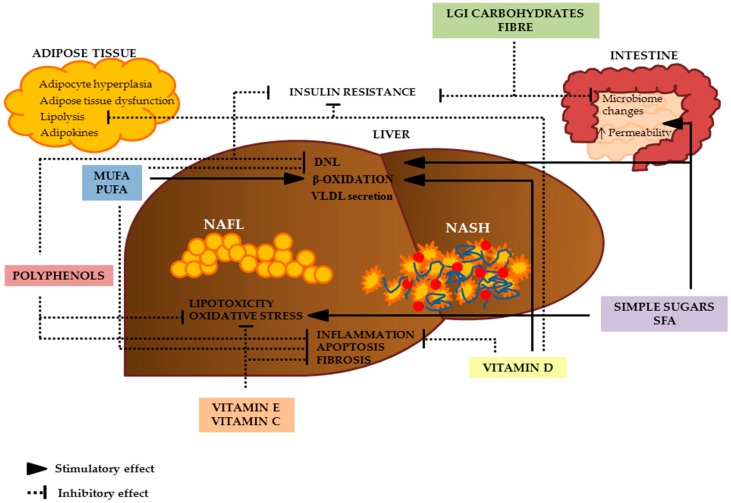Figure 2.
Possible sites of action of dietary nutrients in the nutritional treatment and prevention of NAFLD. Nutrients and dietary composition can modulate many key aspects in the pathophysiology of NAFLD: simple sugars promote DNL, produce inflammation and activate cellular stress pathways. Contrarily, LGI meals can improve insulin resistance and can positively modulate the microbiome. SFA could induce lipogenesis, oxidative stress, and apoptosis of hepatocytes; conversely, MUFA and PUFA can improve FFA β-oxidation and can reduce DNL, improve insulin sensitivity and reduce inflammation. Polyphenols could inhibit DNL and increase FFA β-oxidation. Furthermore, polyphenols can improve insulin sensitivity, reduce the transcription of inflammatory cytokines, and can mitigate the oxidative stress involved in NAFLD progression. Vitamin C and vitamin E could avoid the progression of NAFLD and improve NASH acting as powerful antioxidants; furthermore, vitamin E could reduce plasma levels of cytokines involved in inflammation and liver fibrosis. Vitamin D can reduce the transcription of inflammatory cytokines and improve FFA β-oxidation. Furthermore, it has been observed that vitamin D increases adiponectin secretion, decreases lipolysis in adipose tissue, and improves insulin resistance. DNL: de novo lipogenesis; LGI: low glycemic index; MUFA: monounsaturated fatty acids; NAFLD: non-alcoholic fatty liver disease; NASH: non-alcoholic steatohepatitis; PUFA: polyunsaturated fatty acids; SFA: saturated fatty acids.

